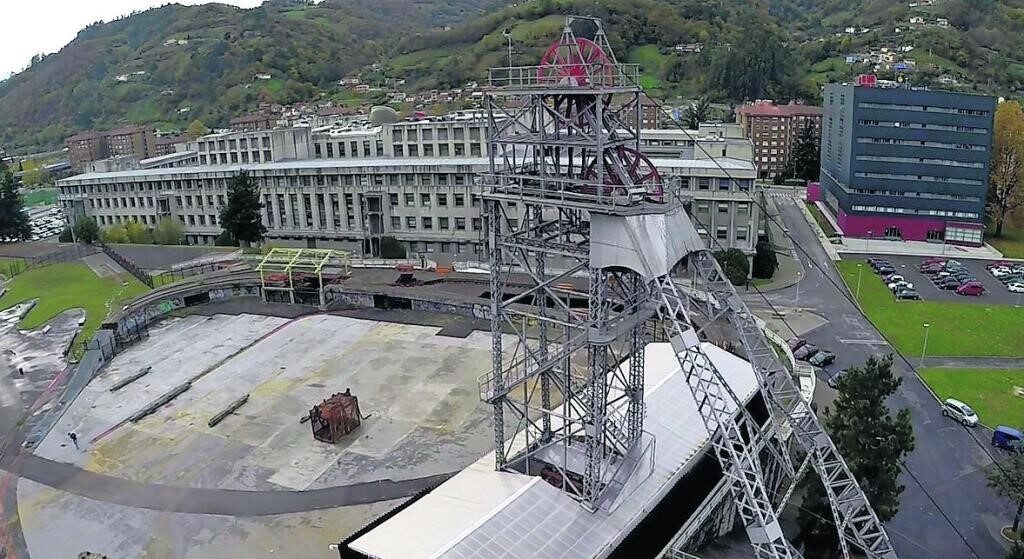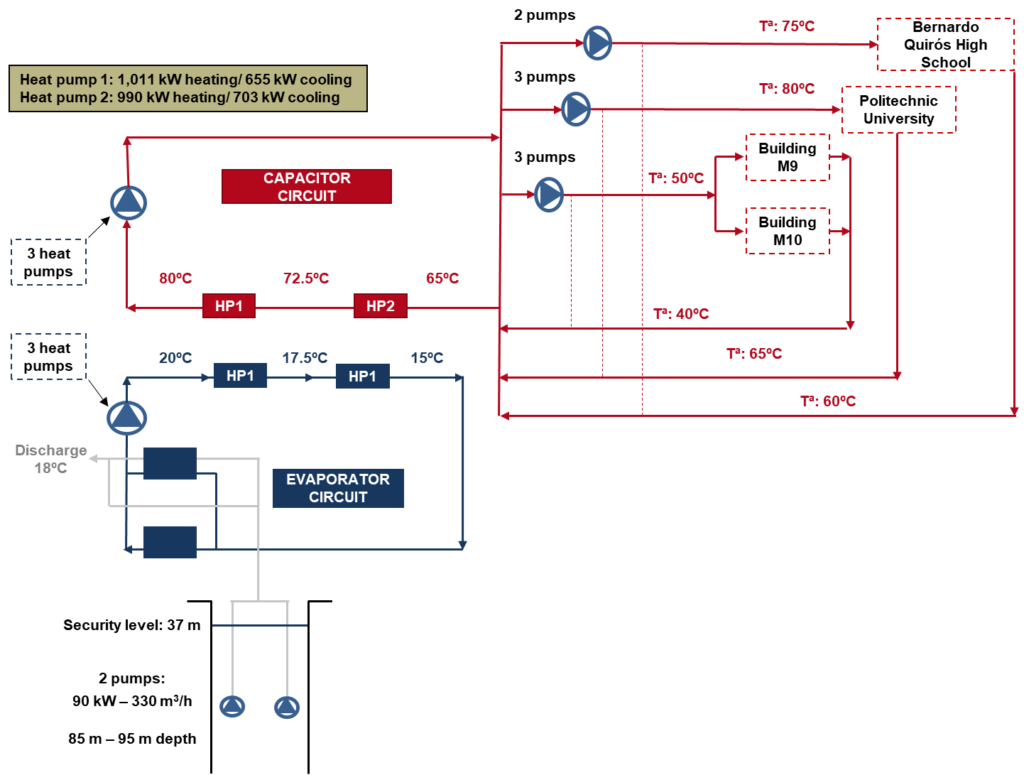- Home
- News
- Industry News
- District heat from an abandoned coal mine
District heat from an abandoned coal mine
- Industry News
- 26 March 2020
- by Grupo Hunosa / Decarb Europe
In order to find alternative uses for a mining site that needed to be closed, Grupo Hunosa partnered with the University of Oviedo to study the feasibility of using the 350-meter flooded well as an alternative energy source.
Please note that this article was originally published by Decarb Europe, here.
In order to find alternative uses for a mining site that needed to be closed, Grupo Hunosa partnered with the University of Oviedo to study the feasibility of using the 350-meter flooded well as an alternative energy source. Last year, they inaugurated a 2 MW geothermal power plant that will supply heat to public facilities as well as two private communities, providing up to 2,880 MWh/year. At the 6th Global District Energy Climate Awards in 2019, this initiative was recognised as a winner in the category of ‘Emerging Market,’ more information is available here.
Heat pumps harness geothermal heat
Grupo Hunosa is a Spanish mining company based in the northern region of Asturias, traditionally specialised in coal mining. Throughout the last decades this sector has experienced a drastic decrease in its workforce, going from more than 25,000 employees in the early 1970s to approximately 700 nowadays. Due to the progressive abandonment of the mining industry in favour of greener energy sources, Hunosa identified the need to diversify their activities.

‘A strategic plan was set in motion to try to position ourselves as an agent in the energy services sector, leading the way in renewable energy sources and the reactivation of traditional mining spots through a new purpose. After assessing several alternatives for our non-active coal mines, we decided to harness the heat of the mine water as energy source to implement a district heating network.’
Abandoned coal mines contain large volumes of water at constant temperatures (increasing with depth by 1-3 °C per 100 m), thanks to their networks of flooded galleries and shafts lying at depths of up to several hundred metres below the surface. Heat pumps can take this geothermal energy and uplift it to a more useful temperature.
In mid-2019, the plant began its exploitation, becoming the largest district heating installation in the country, as the 2 MW provided by the geothermal system were added to a network that was already in place, increasing its total power up to 6 MW.
The project, which required an investment of approximately EUR 1.5 M, has received an incentive from the European Regional Development Fund of EUR 0.5 M; more than 30% of the total. The expected payback is around the 8-year mark, as the expected turnover is EUR 120,000/year. Mieres District Heating’s innovation is a beacon to other agents that might be exploring the possibility of developing renewable energy solutions, as it represents the possibility of developing successful projects repurposing existing technologies. This is achieved through R&D, a joint effort with experts on the field and tailoring the solution to the project’s specifications.
Geothermal energy: ground water at 23°C
The transformation of the Mieres Coal Mine into a district heating network was a complex process. For as long as a coal mine is actively exploited, ground water must be pumped out to lower the water table and to avoid inflowing water in the galleries. The desired soil conditions are achieved by constantly pumping from depths that can go up to 600-1000m. Once the mining exploitation ends, pumps are switched off and the mine gradually fills with ground water. First, the larger mining cavities are filled; then, as the load increases, water starts making its way through the clefts produced by the mining activity; finally, the water fills the ground pores. This flooding process is performed until a security level is reached, so it is assured there is no damage to third parties. Otherwise the flood zones could potentially be impacted, and the situation would be quite difficult to predict as it involves a new aquifer modified by mining activity. Once the baseline pumping level is found, the project can begin to take advantage of the pumped water. Due to the water’s characteristics in terms of quality and temperature (23ºC in this specific case), geothermal energy can be optimally generated.
In order to provide the needed flow to the Mieres district heating system two underwater pumps of 90 kW power were installed, which can pump up to 330 m3/h each, located at depths of 85 and 95 meters under the well´s parapet. Pumped mine water goes through a heat exchanger consisting of three high-end units working in parallel. This allows the mine water to exchange its thermal energy with the clean water that is running through the heat pump’s evaporator.
The heat supply for the district heating network can be found in the building where the extraction machine used to be. Now, the building accommodates two heat pumps working with refrigerant R1234ze, arranged in series and working on counterflow. They are used to heat the water up to the required temperature, reaching up to 2MW of total capacity.

District heating: providing heat for communities
District heating is a solution for providing heat and hot water to a cluster of buildings, which can go from a few houses to entire cities. In the case of the Mieres system, a university, a high school, and two independent buildings are connected to the network.
The main advantage of district heating is that the thermal supply needed is produced in a single power plant and then gets distributed to the consumers through pipelines. This technology is based on the principle that large heat production has higher efficiency than a small one. The only need of end-users is a substation in order to adapt the general supply to their own demand.
The network´s structure enables the supplier to produce all the demanded power from a single power plant, which makes it easier to control emissions and maintenance while making the overall production more efficient and, thus, more profitable.
For district heating networks to be carbon-neutral, there are two options. The first would be to source the heat from renewable energies, usually biomass. The second option would be to use an available heat resource from nature, as is the case with geothermal energy, or from industry, such as the excess heat in metallurgy.
The results: two high temperature and one low temperature heating circuits
The geothermal installation delivers hot water for three circuits at two different temperatures. Two high temperature circuits supply hot water and heating to a university and a high school. This is a breakthrough as heat pumps and refrigerants have been commercially developed, which can raise the water outlet temperature to 75ºC – 80ºC, making it possible to heat buildings whose systems need this temperature range to function properly. Hence, Hunosa adapted their geothermal installation to be able to supply heat to any consumer, even to buildings with conventional heating systems. Then, there is a low temperature circuit that is also used to provide hot water and heating, in this case to two private condominiums. This second system presents broader business opportunities, as it allows the company to access new market segments, helping to improve the overall coefficient of performance of the circuit. Thanks to its innovative setup, the Mieres District Heating system has earned the Global District Heating Award in the Emerging Market category. This prize rewards the successful implementation of a District Energy System in a country that does not yet have an established District Energy market.
The final geothermal installation produces 2 MW that covers 86.5% of the overall energy demand (heat and electricity) from buildings connected to the network. Heating demand is almost completely covered with geothermal energy. In relation to domestic hot water, the geothermal system preheats it only in the heating season (from October to April). Globally this facility supplies roughly 2,880 MWh a year, which translates into an emission reduction of 436 tons CO2 /year as compared to the former individual systems.
The advantages of the system for Mieres
The main benefits the plant has generated for Hunosa and for the Mieres community could be summed up as:
- Centralized operation and maintenance reduce health risks and ease emissions control.
- Reduction of the urban heat island effect by avoiding the generation of heat associated with chimneys, cooling towers, etc. This is due to the fact that in District Heating systems, power generation is concentrated at a single point, usually far from populated areas. However, Hunosa’s case is even more efficient, as the heat is dissipated in the mine water that is discharged into the river and not into the atmosphere.
- More efficient treatment of noise and safety of generating units compared to that of the mine.
- Easier adaptation to new regulations or requirements. HUNOSA’s diversification activities are framed within the commitments set out in a business plan, which is drawn up in response to a gradual reduction in the company’s traditional activities (coal mining) and a diversification focused on, among other things, the development of renewable energies. The objectives are, essentially, the maintenance of employment, and the industrialisation of the mining regions on which the company is based with activities more in line with more efficient and low emission energy models.
- Reduction of environmental impact and energy resources consumption by integrating renewable, residual or local energy supplies into the generation mix.
- Job shift as since the surpluses in employment that the company has due to the closure of the mines must be diverted to other alternative activities of the company. One of these activities is geothermal energy.
- Reduction of energetic dependency.
Latest News
-

-
 26.10.2021 Celsius Summit 2021 – Energy Democracy
26.10.2021 Celsius Summit 2021 – Energy Democracy

